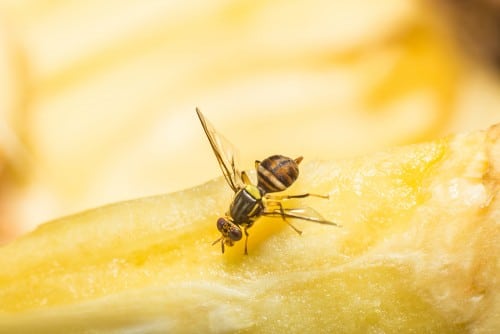The neuroscientists were surprised to find that the "nose" of fruit flies can detect the smells of drugs and explosives, almost exactly like the smells of their favorite food.

By: Ofir Marom
The neuroscientists were surprised to find that the "nose" of fruit flies can detect the smells of drugs and explosives, almost exactly like the smells of their favorite food.
Electronic "noses" seek to imitate the sense of smell developed in animals, which is able to classify complex mixtures of substances in the air into significant categories. Electronic noses that are commercially available today have 18-2 sensors (mainly metal oxide sensors) embedded in them, while most insects have between 300-50 biological sensors, which can operate with a resolution of milliseconds - up to 1,000 times faster than metal oxide sensors.
The fruit fly's well-developed sense of smell allows it to navigate through space, and reach its favorite food source from a great distance. But is he able to identify with the same precision also materials that are not "interesting" to him? As part of a study carried out at the University of Sussex, the researchers documented how 20 different types of olfactory receptors, which are part of the fruit fly's olfactory system, reacted when they were exposed to about 36 chemicals associated with wine (smells characteristic of fermented fruit, a significant part of the fruit fly's diet) and 35 chemicals related to hazardous industrial substances.
The researchers measured the electrical response from the fruit fly's neurons to see which chemicals elicited the strongest response. The researchers then used computer software to simulate the part of the fly's brain used for detection, to show that responses picked up contained enough information to detect odors. The best accuracy in identifying the substances was achieved when all 20 receptors were used; However, by using only 10 or 11 receptors, it was possible to get a correct identification of the tested chemical in about 90% of the times. Apparently, these industrial substances are not essential for the fruit fly's survival, so it can be assumed that its olfactory system has not specifically evolved to detect them. However, contrary to the researchers' expectations, using the smell receptors of the fruit fly, it was also possible to identify industrial materials with great precision.
The long-term goal of the research is to "recreate" animal noses for technical applications such as: detection of explosives, chemical weapons, drugs, spoiled food and a wide variety of other scenarios that require the measurement of small molecules in the air. However, according to the researchers, reproducing the entire nose would be too complicated. It is more likely that it will be possible to produce a device with a limited number of sensors. The research results indicate that a sensing device based on about ten types of receptors can also work (out of about 42 different types in the fruit fly or out of several hundred in dogs) and the research results also indicate which types of sensors are most likely to be suitable for this.

4 תגובות
Hey,
I would love to receive a link to the full article
Indeed the friend from below. In the link you provided you can see (below) more photos he took there and he makes a (better, usually) separation between the fly and the bees.
That's probably the guy from the bottom, the title of the picture http://www.shutterstock.com/pic-295319183/stock-photo-fruit-fly-sucking-sweet-from-ripe-jackfruit.html
fruit fly sucking sweet from ripe jackfruit
It's hard to tell about the fuzzy insect in the lower part of the photo, but the two obvious ones are bees (according to the thickness of the legs) and not fruit flies.
The fruit flies that are used in laboratories for research look like in the following "Hidan" articles:
https://www.hayadan.org.il/implications_for_adhd_in_humans-3101107
https://www.hayadan.org.il/reorganizing-drosophila-1405102